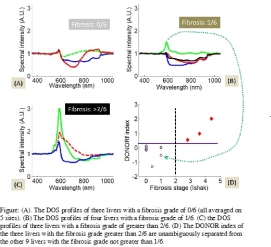Diffuse Optical Non-Invasive Organ Risk (DONOR) Indexing Using Diffuse Reflectance Spectroscopy for Pre-Transplant Evaluation
1College of Medicine, University of Oklahoma, Oklahoma City, OK
2School of Electrical and Computer Engineering, Oklahoma State University, Stillwater, OK
3Oklahoma Transplant Center, University of Oklahoma Health Sciences Center, Oklahoma City, OK
4Pathology, University of Oklahoma, Oklahoma City, OK.
Meeting: 2018 American Transplant Congress
Abstract number: A265
Keywords: Donors, Histology, Liver, marginal, Procurement
Session Information
Session Name: Poster Session A: Liver: MELD, Allocation and Donor Issues (DCD/ECD)
Session Type: Poster Session
Date: Saturday, June 2, 2018
Session Time: 5:30pm-7:30pm
 Presentation Time: 5:30pm-7:30pm
Presentation Time: 5:30pm-7:30pm
Location: Hall 4EF
Purpose: Due to large transplant waitlists, a rapid, non-invasive method to evaluate organ quality for transplantation is needed. Diffuse optical spectroscopy (DOSi) is an optical technology with high spectral with low spatial resolution of functional quantities. In this study, we assessed human livers by DOSi and compared these to the gold standard H&E tissue sections.
Methods: Measurements were acquired from 12 human livers not meeting the criteria for transplantation (IRB #8155.) DOSi has a spectral range of ~350-1050nm, uses a white light source and a compact spectrometer. The surface applicator probe has a pair of light emitting and collecting fibers separated by 3mm. Images obtained from the right and left lobe liver surface and cut sections were measured from a total of five sites for averaging and tissue sections were obtained for H&E controls.
Results: Histologically unremarkable liver number 5 was the DOS baseline for diffuse optical non-invasive organ risk (DONOR) index. The DONOR index represents the level of increased tissue scattering from collagen formation. Surface and parenchymal DOS measurements were similar, and other histopathologic findings did not interfere with the reading. A DONOR index threshold of 0.2 separated 3 livers with an average fibrosis stage > 2 (Ishak, 1995) from 9 livers with an average fibrosis stage≤1.
Conclusion: DOSi can potentially be used in the intraoperative or pre-transplant setting in real time. Ongoing efforts are being made to consolidate the DONOR index for fibrosis grading, assessing steatosis, inflammation, necrosis, and other pathological conditions important to predict organ viability and transplant outcomes. As this technique develops, DOS may be used for pre-transplant donor assessment of solid organs, either in conjunction with cryosection, or a standalone technique. 
CITATION INFORMATION: Borron H., Piao D., Hawxby A., Wright H., Rubin E. Diffuse Optical Non-Invasive Organ Risk (DONOR) Indexing Using Diffuse Reflectance Spectroscopy for Pre-Transplant Evaluation Am J Transplant. 2017;17 (suppl 3).
To cite this abstract in AMA style:
Borron H, Piao D, Hawxby A, Wright H, Rubin E. Diffuse Optical Non-Invasive Organ Risk (DONOR) Indexing Using Diffuse Reflectance Spectroscopy for Pre-Transplant Evaluation [abstract]. https://atcmeetingabstracts.com/abstract/diffuse-optical-non-invasive-organ-risk-donor-indexing-using-diffuse-reflectance-spectroscopy-for-pre-transplant-evaluation/. Accessed January 8, 2026.« Back to 2018 American Transplant Congress
